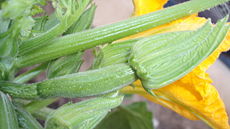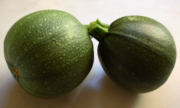Zucchini
| Zucchini / Courgette |
|---|
Zucchini fruit and spent flower on plant 
|
| Species |
| Cucurbita pepo |
| Origin |
| Italy, 19th century (?) |
Zucchini (pronounced /zuːˈkiːni/ in North American and Australian English) or courgette (/kʊǝrˈʒɛt/ or [kɔːˈʒɛt] in New Zealand and British English) is a small summer squash. Along with some other squashes, it belongs to the species Cucurbita pepo. The zucchini can be yellow, green or light green, and generally has a similar shape to a ridged cucumber, though a few cultivars are available that produce round or bottle-shaped fruit.
In a culinary context, zucchini is treated as a vegetable, which means it is usually cooked and presented as a savory dish or accompaniment. Botanically, however, the zucchini is an immature fruit, being the swollen ovary of the female zucchini flower.
Contents |
Flower


The male flower is a golden blossom on the end of each emergent zucchini. The male flower grows directly on the stem of the zucchini plant in the leaf axils (where leaf petiole meets stem), on a long stalk, and is slightly smaller than the female. Both flowers are edible, and are often used to dress a meal or garnish the cooked fruit.
Firm and fresh blossoms that are only slightly open are cooked to be eaten, with pistils removed from female flowers, and stamens removed from male flowers. The stem on the flowers can be retained as a way of giving the cook something to hold onto during cooking, rather than injuring the delicate petals, or they can be removed prior to cooking, or prior to serving. There are a variety of recipes in which the flowers may be deep fried as fritters or tempura (after dipping in a light tempura batter), stuffed, sautéed, baked, or used in soups.
In Mexico, zucchini is often used for a salad, sopa de flor de calabaza, and it is quite popular in a variation of the traditional quesadillas, becoming quesadillas de flor de calabaza. Zucchini is also used in a variety of other dishes (rajas), and as a side dish ornament.
History and etymology

Zucchini, like all summer squash, has its ancestry in the Americas. While most summer squash ― including the closely related cocozelle, and marrow ― were introduced to Europe during the time of European colonization of the Americas, zucchini is European in origin, the result of spontaneously occurring mutations (also called "sports"). In all probability, this occurred in the very late 19th century, probably near Milan; early varieties usually included the names of nearby cities in their name. The alternate name Courgette comes from the French name of the fruit, with the same spelling, and is used in France, Ireland, and the United Kingdom. It is a diminutive of courge, French for squash. "Zucca" is the Italian word for squash; while the feminine diminutive plural "zucchine" is preferred in most regions of Italy, the masculine diminutive plural "zucchini" is used in some areas of Italy, Australia, and the United States. The first records of zucchini in the United States date to the early 1920s. It was almost certainly brought over by Italian immigrants, and probably first emerged in the United States in California.
Cooking

When used for food, zucchini are usually picked when under 8in/20cm in length and the seeds are soft and immature. Mature zucchini can be as much as three feet long, but are often fibrous and not appetizing to eat. Zucchini with the flowers attached are a sign of a truly fresh and immature fruit, and are especially sought by many people.
Unlike cucumber, zucchini are usually served cooked. It can be prepared using a variety of cooking techniques, including steamed, boiled, grilled, stuffed and baked, barbecued, fried, or incorporated in other recipes such as souffles. It also can be baked into a bread. Its flowers can be eaten stuffed and are a delicacy when deep fried as tempura.
The zucchini has a delicate rather than strong flavor requiring little more than quick cooking with butter or olive oil, with or without fresh herbs. The skin is left in place. Quick cooking of barely wet zucchini in oil or butter allows the vegetable to partially boil and steam, with the juices concentrated in the final moments of frying when the water has gone, prior to serving. Zucchini can also be eaten raw, sliced or shredded in a cold salad, as well as hot and barely cooked in hot salads, as in Thai or Vietnamese recipes.
Zucchini fruit should be stored not longer than three days. They are prone to chilling damage which is expressed as sunken pits in the surface of the fruit especially when brought up to room temperature after cool storage.

In 2005, a poll of 2,000 people revealed the courgette to be the Britain's 10th favorite culinary vegetable. In Mexico, the flower (known as flor de calabaza) is preferred over the vegetable, and is often cooked in soups or used as a filling for quesadillas. In El Salvador, calabaza is a common ingredient in pupusas, usually with cheese as calabaza y queso.
In Italy, zucchini are served in a variety of ways, especially breaded and pan-fried. Some restaurants in Rome specialize in deep-frying the flowers, known as fiori di zucca.
In France zucchini is a key ingredient in Ratatouille, a stew of summer vegetables in olive oil, cooked for an extended time over low heat. The dish, originating around an area known as present day Nice is served as a side dish or on its own at lunch with bread.
In Turkish cuisine zucchini is the main ingredient in the popular dish mücver , or "zucchini pancakes", made from shredded zucchini, flour and eggs, lightly fried in olive oil and eaten with yogurt.
In Libya, after being emptied, zucchini is stuffed with minced meat and rice plus herbs and spices and steamed. It is also used to make various kinds of stew.
In Greece, zucchini is usually fried or boiled with other vegetables. It is served as a Hors d'œuvre, or during fasting seasons as a main dish. In several parts of Greece the flowers of the plant are stuffed with white cheese, usually feta or Mizithra cheese, or with a mixture of rice and herbs. Then they are deep-fried, or, less often, baked in the oven with tomato sauce.
In Bulgaria, zucchini are fried and then served with a dip, made from yoghourt, garlic and dill. Another very popular dish is oven-baken zucchini - sliced or grated - covered with a mixture of eggs, yoghourt, flour and dill.
Nutrition
The zucchini vegetable is low in calories (approximately 15 food calories per 100 g fresh zucchini) and contains useful amounts of folate (24 mcg/100 g), potassium (280 mg/100 g) and vitamin A (384 IU [115 mcg]/100 g. 1/2 cup of zucchini also contains 19% of the recommended amount of manganese.
Cultivation
Zucchini is one of the easiest vegetables to cultivate in temperate climates. As such, it has a reputation among home gardeners for overwhelming production. One good way is to harvest the flowers, which are a very expensive delicacy in markets because of the difficulty in storing and transporting them. The male flower is borne on the end of a stalk and is longer-lived.
While easy to grow, zucchini, like all squash, requires plentiful bees for pollination. In areas of pollinator decline or high pesticide use, such as mosquito spray districts, gardeners often experience fruit abortion, where the fruit begins to grow, then dries or rots. This is due to an insufficient number of pollen grains delivered to the female flower, and can be corrected by hand pollination or by increasing the bee population.
Closely related to zucchini are Lebanese summer squash or kusa, but they often are lighter green or even white. Some seed catalogs do not even distinguish them.
References
- ITIS 22365 6 November 2002